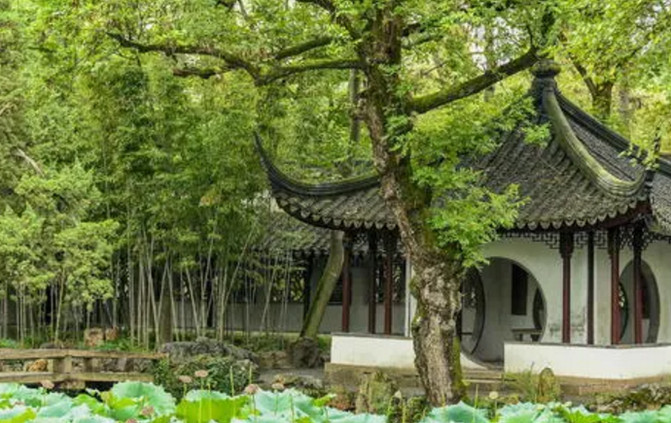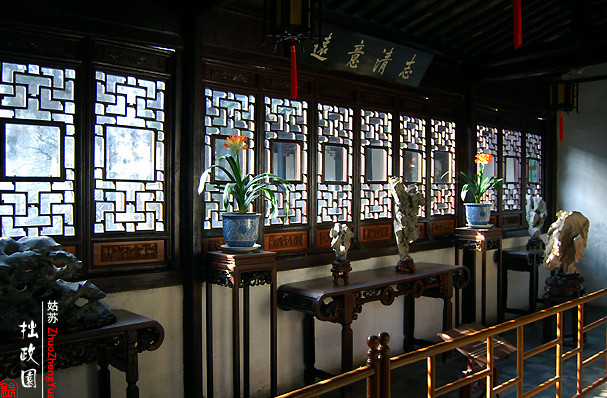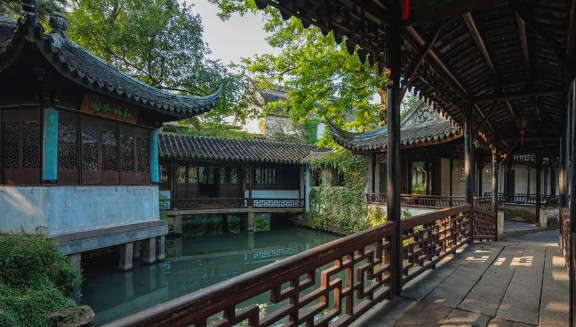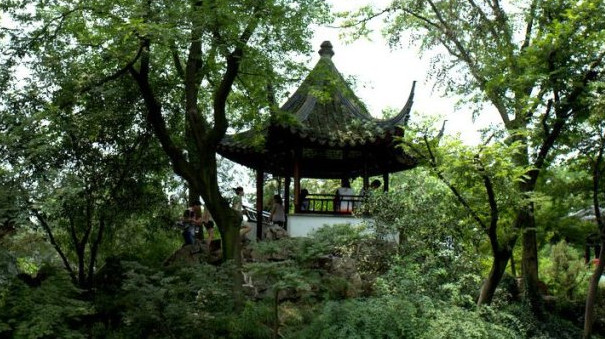Humble Administrator's Garden, Mother of Gardens in the World (Part 2)-Suzhou 2 (3)
★ Tourist location: Zhongzhong Garden of Suzhou Humble Administrator Garden
Middle Garden is the main scenic spot of Humble Administrator's Garden and the essence of the whole garden. It covers an area of about 18.5 acres and is arranged with the pool as the center. The garden buildings maintain the rich, simple and sparse artistic style of Ming Dynasty gardens. Compared with East Garden, the area here is smaller and larger. If you deduct a large amount of water area, the land area is even smaller. The number and scale of buildings are much more and larger than East Garden.
From the East Garden to the Middle Garden, the first thing you see is a pavilion-Wuzhu Youju, which takes the homophonic sound of "I am in peace" in Wu dialect, which means that with such a quiet and comfortable pavilion, I can live comfortably. This is the main viewing view of the central pool east, backed by the promenade and facing the pond, with sycamore trees and green bamboos next to it. For the ancients, Wu and bamboo were both the most clear and secluded things. There were "phoenixes that would not live unless they were parasol trees, and they would not eat anything unless they were bamboo."
This pavilion not only has a unique name, but also has a unique architectural style. Four circular cave doors are opened on the white walls around them, which are both transparent and elegant, but also form four framed scenes hidden by flower windows. In addition, holes ring holes, holes within holes, and unique landscapes of overlapping and staggered circles, rings, and connected circles can be seen from different angles. The plaque on the pavilion was inscribed by Wen Zhengming, and the couplets on both sides were written by Zhao Zhiqian, a famous calligrapher in the late Qing Dynasty: "Enjoy the breeze and shine the moon, watch the flowing water and watch the mountains."
There are lotus leaves and fields on the water around us, but unfortunately the lotus flowers have already bloomed. I couldn't help but feel a little resentful: "What kind of lotus flowers are in Humble Administrator's Garden? Why are the lotus flowers almost blooming in August? When we were in Yinyuan before, September was still so lush!"
The little friend reminded weakly: "Actually, it's already the end of August. Look, September is only three days away. So…"
Okay, so we can't blame people for blooming too early. It's really not the best time for us to come. Fortunately, without the lotus flowers, we can better appreciate the gardens of Humble Administrator's Garden. Otherwise, if we just patronize the lotus flowers, we would put the cart before the horse. I can only comfort myself.
There are two small islands in the pond, called Dongxishan Islands. There are tree-lined areas on the island, and small bridges are built between the ravines to pass through. A six-corner viewing pavilion and a frost-waiting pavilion were built high on the East Island. The name sounds like an autumn scenery. It is based on Wei Yingwu's poetry of "Dongting must be filled with forest frost." Therefore, orange trees are also planted around the pavilion. In autumn, when the frost comes, the branches are full of oranges. It is said that there was also a couplet written by Weng Tonghe outside the pavilion: "Ge turban and feather fan are quiet in the dust, and the road of purple plum cucumber village is fragrant." Nowadays, you can't see purple plum cucumbers in Humble Administrator's Garden, and there are no village roads. Although the garden scenery is quiet, it is actually located in the busy city of Suzhou.
At the top of the West Island is the Snow Fragrance Cloud Wei Pavilion, which is a simple rectangular square pavilion. The name of the pavilion is a bit special."Xuexiang" refers to white plum blossoms, and "Yunwei" refers to the scale of Meilin. This place is suitable for enjoying plum blossoms in early spring, also known as the Winter Pavilion.
There are two pavilions in the north and south on the east bank of the pond, named Luyi Pavilion and Luyi Pavilion respectively. When I first saw the names of the pavilions, I thought the names of the two pavilions were the same. Lvyi Pavilion is the northernmost attraction in Humble Administrator's Garden. It is adjacent to water on one side, towering ancient trees on the south, and green bamboo forests on the north, making it a very quiet place.
The Green Qi Pavilion is built on a rockery and is rectangular. Because the terrain is relatively high, you can climb high and look into the distance. Although to be honest, it is not very high, you can at least have a view of the Garden of China, and the view is still good. The name of the pavilion hangs under the west eaves of the pavilion, and there is a couplet on the west pillar: "Born straight and diligent, harmonious and thick in life." I don't know who wrote it or where it was originally hung. I always feel that it is a bit out of line with the artistic conception of Humble Administrator's Garden.
Yuanxiang Hall, located on the south bank of the pool, is a four-sided hall, a single eaves resting on the top of the mountain, and a wide surface. It is the main building of the Middle Garden. It can even be said to be the main building of the entire Humble Administrator's Garden. Many buildings are designed around Yuanxiang Hall. In summer, the lotus wind blows on the pond in the north. The so-called distant fragrance refers to the fragrance of lotus, which means "the fragrance is far and clear" in Zhou Dunyi's "On Love Lotus".
This is the place where the host banquets guests. There are long transparent windows on all sides, allowing you to see the beautiful scenery around you. It turns out that this is Ruoshu Hall. It was built on the former site during the Qianlong period of the Qing Dynasty. The bluestone roof foundation was the original thing at that time.
In the west of Yuanxiang Hall, there is a Yiyu Pavilion, facing east-west. It takes the poem of Wen Zhengming's "Yiying on a jade and thousands of poles long", describing bamboo as jade and praising its purity.
Walking west, you will see a covered bridge. The vermilion bridge railing is reflected in the water like a flying rainbow, hence the name Xiaofeihong. The two ends of the bridge are connected to the curved corridor, and there are ten thousand guardrails on both sides of the bridge deck, with three rooms and eight pillars, covering the corridor houses.
Yulan Hall is an independent and closed quiet courtyard, tall and spacious. It turned out to be called Bihua Hall. The south wall stands tall like painting paper, and the vines and grass spread like lines under the pen. The flower beds under the wall are planted with Tianzhu and green bamboo, and of course magnolias are indispensable. It's just that people are not in the flower season and don't see flowers.
Xiangzhou is a boat-like structure with two floors of cabins. It is named after Qu Yuan's "Chu Ci" meaning "Cai Fang Zhou Xi Du Ruo". In ancient times, vanilla was often used to compare a person with a noble character. The bow is a platform, the front cabin is a pavilion, the middle cabin is a pavilion, the stern is a pavilion, and there is a building on the pavilion. The lines are soft and undulating. One boat combines multiple architectural styles of pavilions, pavilions and pavilions. There are actually many untied boats in Jiangnan gardens, but perhaps the Xiangzhou shape in Humble Administrator's Garden is the most beautiful. The inscription on the bow of the ship was also written by Wen Zhengming. This scholar is said to have participated in the design of Humble Administrator's Garden. No wonder his inscription is everywhere.
The lotus wind pavilion is built close to the water. There is a couplet in the pavilion: "There are lotus flowers on the four walls and willows on the three sides, and half a pool and autumn water are a Fangshan." It is said that four sides of lotus flowers and three sides of willows seem to be the characteristics of Daming Lake in Shandong Province. People are "four sides of lotus flowers and three sides of willows, one city of mountains and half a city of lake." The pavilion is surrounded by water on all sides, and willows are planted on the bank. Of course, the lotus flowers are almost in bloom, but the lotus leaves are still very green.
The Pine Wind Water Pavilion is also known as the Pine Wind Listening Place. It has a sharp and square roof. It is accessed by a small door in the corridor. The other three sides adopt a structure of half walls and half windows. The roof has large eaves and the flying eaves are raised high, making it elegant and light. In particular, this water pavilion is not oriented directly north and south, but is tilted at a 45-degree angle and is placed on the water in the sky. Water Pavilion is the most suitable building for viewing in summer. Black pine trees are planted next to the pavilion, and it is also the elegant love of literati to watch the pine trees and listen to the waves.
I don't know how I got there, but I walked to the West Garden as soon as I came out of the Water Pavilion. I quickly checked the map and found that a few small attractions had been missed. Although he could still check for gaps and fill in gaps again after returning from the West Garden, he had to go back and finish the Middle Garden first. Anyway, it's not the first time we've lost our way in the garden. These buildings go back and forth, and it's easy to turn back twice.
Dezhen Pavilion is quite large. There is a curved corridor on one side connected to other buildings, and there is a couplet on the wall: "Pine and cypresses have their nature, and gold and stone show the heart of alliance." Probably to echo this couplet, pine and cypress are indeed planted around the pavilion.
Go straight ahead from the veranda and you will lead to Xiaocanglang. This is a water courtyard. It is actually very close to Xiao Feihong, but we missed it perfectly while walking just now. There is also a garden in Suzhou called Canglang Pavilion, which may be borrowed here. This building should be a pavilion, with a wide surface of three rooms, a south window and a north sill, and two faces the water. It looks like a house and a boat. It can barely be said to be a bridge, but it is a water pavilion completely erected on the water. Xiao Canglang's couplet was inscribed by Wen Zhengming: "Tea begins to taste in the dark, and books are still in the middle." It seems that this is a good place to taste tea. In the Northern Song Dynasty, Su Shunqin named the pavilion "Canglang Pavilion", which meant to retreat from the world. Drinking tea was indeed a common thing for hermits.
Jiashi Pavilion is a small pavilion with an unusual shape. It has a white wall on the back and a small rectangular window, which just frames the scenery outside the wall. It is naturally a beautiful landscape painting. The inscription on the forehead was titled "Zheng Ming", but it is said that it was not the original source of Wen Zhengming-it was copied by later generations.
Next to the pavilion is the loquat garden. It is said that some of the loquat trees in it were planted by Li Xiucheng, the loyal king of the Taiping Rebellion. I don't know if they are true.
To the east of Jiashi Pavilion is Tingyuxuan, which is connected to other surrounding buildings with curved corridors. There is a pool of clear water in front of the pavilion, plantains and green bamboos are planted by the pool, and there is also a cluster of plantains behind the pavilion. Rain beating plantains is also a kind of nature's music. There happened to be a team visiting, and the tour guide quoted classics and talked directly about the wonderful artistic conception of listening to the rain. Unfortunately, the sun is shining today. Even if the sun occasionally hides in the clouds, it won't rain. Therefore, we will not appreciate the beauty of listening to the rain.
Haitang Chunwu is an independent courtyard with a book-like brick forehead. There are two crabapple trees in the courtyard, and the green, red, and white pebbles on the floor are inlaid with crabapple patterns. There are almost no tourists here, and it probably won't be its highlight until spring when the crabapple blossoms are in full bloom.































Previous Article:Refining clay into gold, this "Su made" craft almost lost, what kind of story is hidden behind it
Next Article:Suzhou Tantai Lake Hotel, Jiangsu Canal Banquet
